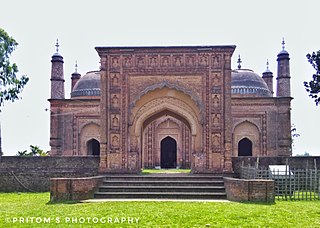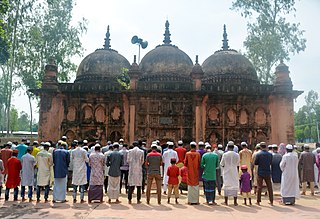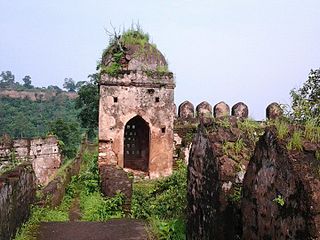
Mymensingh District is a district in Mymensingh Division, Bangladesh, and is bordered on the north by Meghalaya, a state of India and the Garo Hills, on the south by Gazipur District, on the east by the districts of Netrokona and Kishoreganj, and on the west by the districts of Sherpur, Jamalpur and Tangail. Mymensingh is the 8th administrative divisional headquarter and 12th city corporation of Bangladesh. According to Ministry of Public Administration, Mymensingh is ranked 4th in district status. The density of Mymensingh city is 44,458/km2 which is the second most densely populated city in Bangladesh. Mymensingh attracts 25 percent of health tourists visiting Bangladesh. Once known as the largest district of the Indian subcontinent. Mymensingh town is the district headquarters.

Thakurgaon District is a district in northwestern Bangladesh. It is part of the Rangpur Division and borders India to the west. It was established as a mahakuma in 1860 consisting of 7 thanas named Thakurgaon sadar, Baliadangi, Pirganj, Ranishankail, Haripur, Bhulli and Ruhia. In 1947, it was re-established as a mahakuma including 3 thanas of Jalpaiguri and a thana of kochbihar of India. In 1981, Atoari was included in the new Panchagarh district and the area was shrunk in just 5 thanas. It was established as a district on 1 February 1984.

Dharmapasha (Bengali: ধর্মপাশা, romanized: Dhormopasha, also spelled as Dharampasha or Dharamapasha, is an upazila of Sunamganj District in the Division of Sylhet, Bangladesh.

Aditmari is the smallest upazila (sub-district) of Lalmonirhat District in Rangpur Division, Bangladesh.

Mithapukur is an upazila of Rangpur District in the division of Rangpur, Bangladesh. The upazila is situated in the middle of Rangpur, surrounded by Rangpur Sadar to the north, Pirganj to the south, Badarganj and Phulbari to the west and Pirgachha and Sundarganj to the east. Mithapukur is famous for being the birthplace of Begum Rokeya and its sweet mango Harivanga.

Pirganj is an upazila of Rangpur District in the division of Rangpur, Bangladesh. Pirganj Upazila area 411.35 km2, located in between 25°18' and 25°31' north latitudes and in between 89°08' and 89°25' east longitudes. It is bounded by Mithapukur Upazila on the north, Palashbari Upazila on the south, Ghoraghat Upazila and Nawabganj Upazila on the west, Sadullapur Upazila on the east.

Pirganj is an upazila of Thakurgaon district in Rangpur Division, Bangladesh.

The Palamu kila are two ruined forts located 3 k.m from Betla National Park, Latehar district on the bank of Auranga River, in the Indian state of Jharkhand. The old fort in the plains, which existed even before the Chero dynasty, was built by the King of Raksel dynasty. The original fort in the plains and the other on an adjoining hill are attributed to the kings of the Chero dynasty. The fort in the plains had defences on three sides and three main gates. The New fort was constructed by Raja Medini Ray. East India company used this fort to prison Narayan Peshwa of Tiroha and Raja Harsh dubey alias Subedar Aftab Singh mutineers of 1857.

Ghughudanga Zamindar Bari was the residential palace and place of business of the Ghughu-danga zamindar family. It is situated on the banks of the Purnobhoba River in Dinajpur District. The palace was destroyed by Pakistani soldiers in the 1971 Bangladesh Liberation War.

Haripur Barabari or Haripur Zamindar Bari is a palace in Horipur Union of Nasirnagar Upazila at Brahmanbaria district, Bangladesh earlier part of former British Bengal. This palace founded by Jamindar Krishna Prasad Roy Choudhury(1870-1936) in eighteenth century. This palace stands for the witness of Zamindar system of tax exploitation.

Mankar is a village in Galsi I CD Block in Bardhaman Sadar North subdivision of Purba Bardhaman district in the state of West Bengal, India.

Tangail District is quite famous for its zamindari rule with three of the largest zamindars in the region believed to have been established during the Mughal period. In addition, several small zamindar classes developed in this area, whose reputation is still evident. One of such zamindar is Mohera Zamindar Bari. Mohera Zamindar Bari is a 19th-century Zamidari residence in Mirzapur, Tangail District, Bangladesh. It is used as a police training school. The zamindar house was established in the mirzapur before the 1890s. Mohera zamindar Bari is the most preserved and maintained zamindari Bari of Bangladesh locally. There is no such zamindari Bari as preserved and maintained as it is in the country. The zamindari Bari represents our culture, lifestyle, and history during British time.

Nandirhat Zamindar Bari was a zamindar residence of Laksmicaran Saha. It is located at Nandirhut, Hathazari. Composer and Musician Satya Saha was born in this house.

The zamindars of Mahipur were a Bengali aristocratic family of feudal landowners. The zamindari estate encompassed the Chakla of Qazirhat under the Cooch Behar State since the Mughal period. Although their aristocratic status was lost with the East Bengal State Acquisition and Tenancy Act of 1950, the Mahipur estate remains an important part of the history of Rangpur and belongs to one of the eighteen ancient zamindar families of Rangpur. The zamindari palace was lost as a result of flooding from the Teesta River, although the mosque, cemetery, polished reservoir and large draw-well can still be seen today.

The Gunahar Zamindar Bari was a zamindari estate based in the Bogra District of Bangladesh. The residential palace, popularly known as Saheb Bari, was the erstwhile Zamindars of Gunahar in Dhupchanchia. The present building was constructed in 1941, and remains a tourist attraction.

The Sanggāi Yumpham, was the citadel, a fortified royal residence within the Kangla Fort, Imphal. It is preserved as an archaeological site as well as a tourist attraction.
Kashipur Zamindar Bari is a historical place. It is a memorial place of Saratchandra Chattopadhyay. It is currently located in Chuadanga District of Bangladesh.

Birulia is a village in Dhaka District of Bangladesh. It is a union council under the Savar Upazila.

Muktagacha Zamindar Bari or Aat Ani Zamindar Bari is an ancient zamindar palace located in Muktagacha Upazila of Mymensingh District, Bangladesh. The zamindar of Muktagacha was given the title of first Raja and then Maharaja by the British Raj, so the zamindar's residence was called Rajbari.

The Itakumari Zamindar House is a historical Residence located in Pirganj Upazila of Rangpur District in Bangladesh.


















